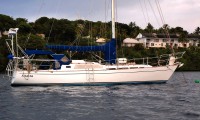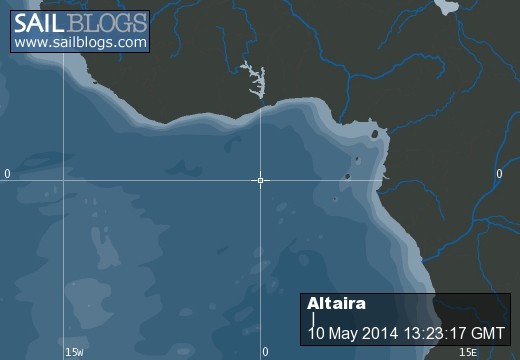Profile

Who: Kimball Corson. Text and Photos not disclaimed or that are obviously not mine are copyright (c) Kimball Corson 2004-2016
Port: Lake Pleasant, AZ
Altaira Wandering the Oceans
Favorites
- 7 Seas Cruising Association
- American Sailing Association
- Buoyweather Service
- CDC Traveler's Heath Advisories
- Cruiser Log venue
- Cruisers Forum
- Cruising Club of America
- Cruising Resources
- Cruising World Magazine
- Earthrace World Record
- Economic and Financial Indicators
- Economist Magazine
- Equipmment and Boat Reviews
- Float Plan Form
- Greenpeace Int'l
- Grib File Access
- Heavy Weather Sailing
- IMS Certificates
- Inland Travel: Expedia
- Intrade Prediction Markets
- Latitude 38
- London Financial Times
- Marine Books and Charts
- Marine Radios
- Nature Conservancy for Oceans
- New York Times
- NOAA Hurricane Analysis
- NOAA Weather Forecasts
- Noonsite, World Cruisng Info
- Ocean Cruising Club
- Overseas Mail Forwarding Services
- Practical Sailor Magazine
- RGE Economic Monitor
- Sail Gear Source I
- Sail Gear Source II
- Sail Gear Source III
- Sail Gear Source IV
- Sailboat Selection for Offshore Use
- Sailboats for Sale
- Sailing Items Sources Links
- SailMail (Marine Radio)
- Sailnet Sailing Information
- Seeking Alpha
- Tide & Current Program
- Tide Prediction Programs
- Tides & Currents
- TruthDig in the News
- U.S. Sailing Association
- Univ of Chicago Law Faculty Blog
- US State Dept Travel Advisories
- Voyage Planning (with pilot charts)
- Wall Street Journal
- Washington Post
- Weather.com
- Weather: MagicSeaweed
- Weather: Wetsand
- WinLink (Ham Radio)
- World Clock + Time Zones
09 April 2018 | Pago Pago, American Samoa
10 March 2018 | Pago Pago, American Samoa
10 March 2018 | Pago Pago, American Samoa
10 March 2018 | Pago Pago, American Samoa
22 August 2017 | Pago Pago, American Samoa
22 August 2017 | Pago Pago, American Samoa
22 August 2017 | Pago Pago, American Samoa
22 August 2017 | Pago Pago, American Samoa
22 August 2017 | Pago Pago, American Samoa
22 August 2017 | Pago Pago, American Samoa
22 August 2017 | Pago Pago, American Samoa
22 August 2017 | Pago Pago, American Samoa
22 August 2017 | Pago Pago, American Samoa
22 August 2017 | Pago Pago, American Samoa
22 August 2017 | Pago Pago, American Samoa
22 August 2017 | Pago Pago, American Samoa
22 August 2017 | Pago Pago, American Samoa
22 August 2017 | Pago Pago, American Samoa
22 August 2017 | Pago Pago, American Samoa
09 August 2017 | Pago Pago, American Samoa
So How Can We Tell What Is True?
06 December 2016 | Pago Pago, American Samoa
Kimball Corson
Stanford University professor Robert N. Proctor explains the practice of "Agnotology" (poor choice of language, I think) is the creation and promulgation of misinformation and disinformation, generated by special interest groups, to create public confusion, to undermine honest and legitimate authority and to suppress the truth on societally important issues, mostly on matters of science and economics. The question then put is how can a member of the public know what is true in this sea of conflicting information.
First, the task is ever and always an individual one. Second, several things need to be considered regarding a particular quantum of information. They are --
a) what is its source?
b) what is the reputation of that source for credibility?
c) what sources agree and disagree with that source?
d) does the source present the information neutrally or is something more requested, impliedly or otherwise, from the reader?
e) what are the positions on that information of top colleges and universities and why?
f) do the American Academy of Sciences and other specialty associations in the area agree with that information?
g) does the information stand up to analysis and is it logically compatible with other known information?
The last test g) somewhat begs the question by presuming the reader or hearer is capable of analysis and knows other information to compare it to for compatibility. That brings me to h) the individual's strong need 1) for a quality and usually higher education, and 2) to be widely and well read across a broad range of topics and issues from nominally authoritative sources.
These acquisitions are hard, time consuming and often expensive to get but they lead to the skill of critical thinking and having a knowledge base on which to apply it, when both are properly sought and developed for that end. They are the best test for veracity and where the American public increasingly misses the boat most badly, especially with declining reading skills. That is why political lying can now be so successful and is used so much more aggressively now.
Little misinformation and disinformation can slip by all of these screens, especially h). But several points remain noteworthy. First, look how much work and effort those disseminating bad information put the rest of us to. And, secondly, consider the ability of average Americans to apply these screens or tests. Pretty scant among most I am afraid which makes the practice of agnotology increasingly worthwhile. With declining IQ's, declining reading skills and falling educational standards and opportunities and with the cost of a good education rising out of reach of most, the prognosis is not good even for those who try to apply these screens, especially h).
Deceit, which was learned from the American business community, has made huge inroads into the provision of information and into the media. America is largely unable to deal with it and that is a reason we have the huge political divisions in the country that we do. They will persist, with the ill-informed believing what they want to believe, as I have explained and how elsewhere. Divided so, Americans cannot agree and act with any unity on many issues. We are permanently fractured.
The outlook is poor, especially with the border-line illiterate media personnel we have giving us much of the defective information we acquire.
First, the task is ever and always an individual one. Second, several things need to be considered regarding a particular quantum of information. They are --
a) what is its source?
b) what is the reputation of that source for credibility?
c) what sources agree and disagree with that source?
d) does the source present the information neutrally or is something more requested, impliedly or otherwise, from the reader?
e) what are the positions on that information of top colleges and universities and why?
f) do the American Academy of Sciences and other specialty associations in the area agree with that information?
g) does the information stand up to analysis and is it logically compatible with other known information?
The last test g) somewhat begs the question by presuming the reader or hearer is capable of analysis and knows other information to compare it to for compatibility. That brings me to h) the individual's strong need 1) for a quality and usually higher education, and 2) to be widely and well read across a broad range of topics and issues from nominally authoritative sources.
These acquisitions are hard, time consuming and often expensive to get but they lead to the skill of critical thinking and having a knowledge base on which to apply it, when both are properly sought and developed for that end. They are the best test for veracity and where the American public increasingly misses the boat most badly, especially with declining reading skills. That is why political lying can now be so successful and is used so much more aggressively now.
Little misinformation and disinformation can slip by all of these screens, especially h). But several points remain noteworthy. First, look how much work and effort those disseminating bad information put the rest of us to. And, secondly, consider the ability of average Americans to apply these screens or tests. Pretty scant among most I am afraid which makes the practice of agnotology increasingly worthwhile. With declining IQ's, declining reading skills and falling educational standards and opportunities and with the cost of a good education rising out of reach of most, the prognosis is not good even for those who try to apply these screens, especially h).
Deceit, which was learned from the American business community, has made huge inroads into the provision of information and into the media. America is largely unable to deal with it and that is a reason we have the huge political divisions in the country that we do. They will persist, with the ill-informed believing what they want to believe, as I have explained and how elsewhere. Divided so, Americans cannot agree and act with any unity on many issues. We are permanently fractured.
The outlook is poor, especially with the border-line illiterate media personnel we have giving us much of the defective information we acquire.
Comments
| Vessel Name: | Altaira |
| Vessel Make/Model: | A Fair Weather Mariner 39 is a fast (PHRF 132), heavily ballasted (43%), high-aspect (6:1), stiff, comfortable, offshore performance cruiser by Bob Perry that goes to wind well (30 deg w/ good headway) and is also good up and down the Beaufort scale. |
| Hailing Port: | Lake Pleasant, AZ |
| Crew: | Kimball Corson. Text and Photos not disclaimed or that are obviously not mine are copyright (c) Kimball Corson 2004-2016 |
| About: | |
| Extra: |
Altaira's Photos - Main
No items in this gallery.
Profile

Who: Kimball Corson. Text and Photos not disclaimed or that are obviously not mine are copyright (c) Kimball Corson 2004-2016
Port: Lake Pleasant, AZ
Altaira Wandering the Oceans
Favorites
- 7 Seas Cruising Association
- American Sailing Association
- Buoyweather Service
- CDC Traveler's Heath Advisories
- Cruiser Log venue
- Cruisers Forum
- Cruising Club of America
- Cruising Resources
- Cruising World Magazine
- Earthrace World Record
- Economic and Financial Indicators
- Economist Magazine
- Equipmment and Boat Reviews
- Float Plan Form
- Greenpeace Int'l
- Grib File Access
- Heavy Weather Sailing
- IMS Certificates
- Inland Travel: Expedia
- Intrade Prediction Markets
- Latitude 38
- London Financial Times
- Marine Books and Charts
- Marine Radios
- Nature Conservancy for Oceans
- New York Times
- NOAA Hurricane Analysis
- NOAA Weather Forecasts
- Noonsite, World Cruisng Info
- Ocean Cruising Club
- Overseas Mail Forwarding Services
- Practical Sailor Magazine
- RGE Economic Monitor
- Sail Gear Source I
- Sail Gear Source II
- Sail Gear Source III
- Sail Gear Source IV
- Sailboat Selection for Offshore Use
- Sailboats for Sale
- Sailing Items Sources Links
- SailMail (Marine Radio)
- Sailnet Sailing Information
- Seeking Alpha
- Tide & Current Program
- Tide Prediction Programs
- Tides & Currents
- TruthDig in the News
- U.S. Sailing Association
- Univ of Chicago Law Faculty Blog
- US State Dept Travel Advisories
- Voyage Planning (with pilot charts)
- Wall Street Journal
- Washington Post
- Weather.com
- Weather: MagicSeaweed
- Weather: Wetsand
- WinLink (Ham Radio)
- World Clock + Time Zones
